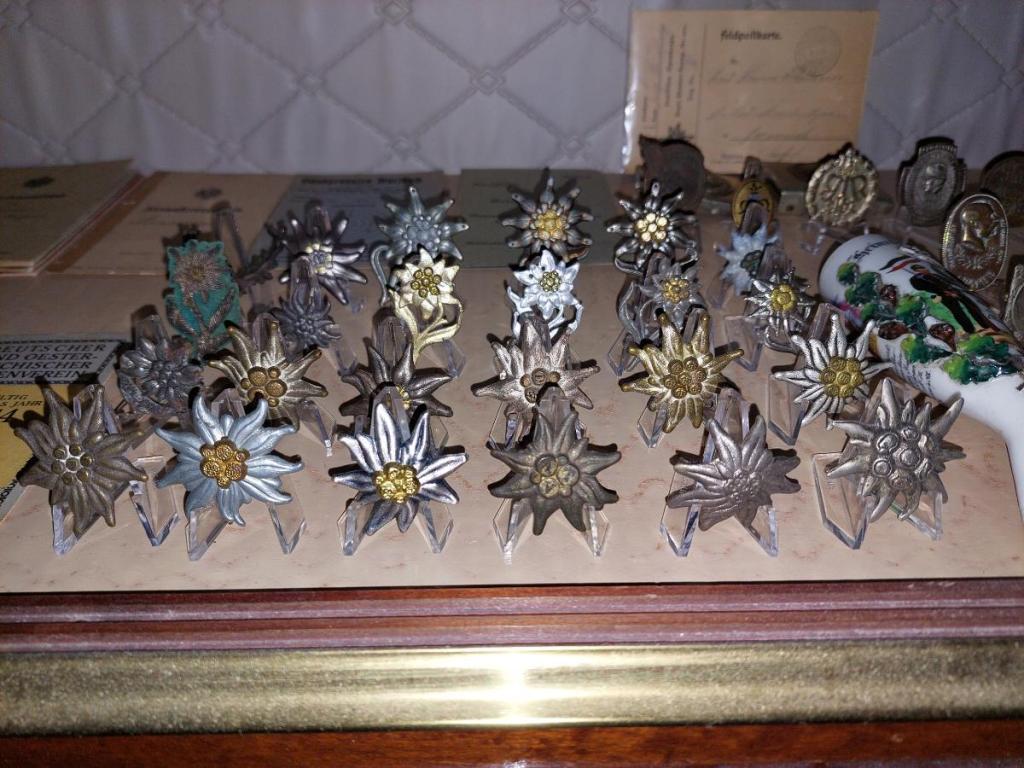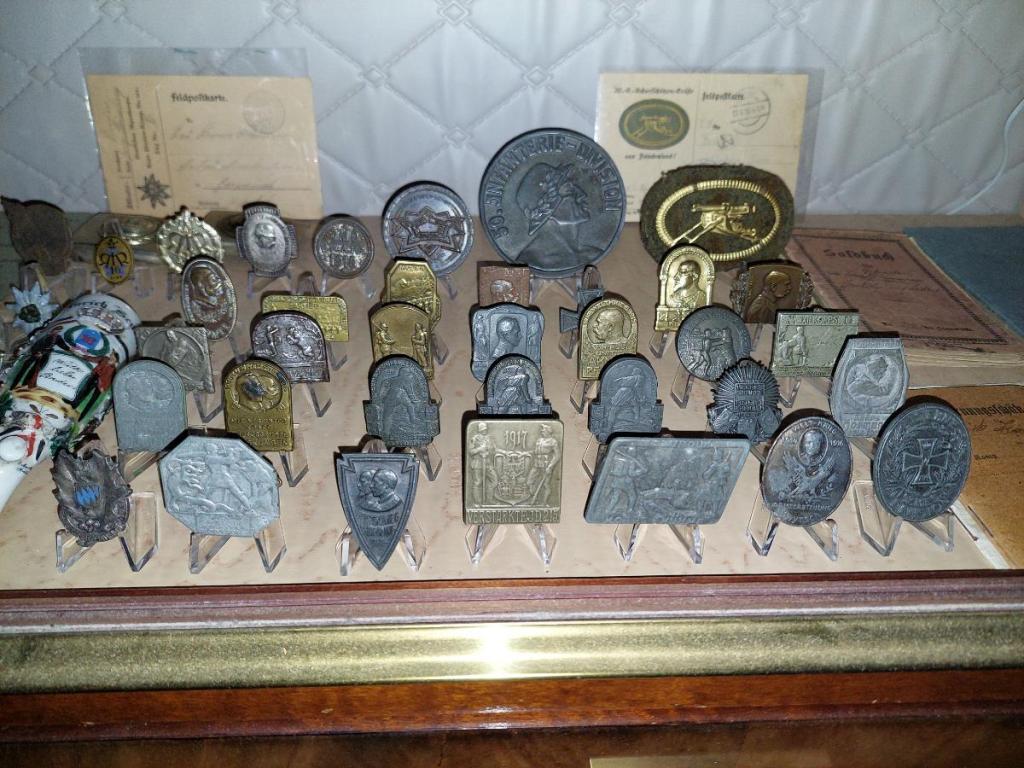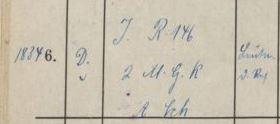-
Posts
3,071 -
Joined
-
Last visited
-
Days Won
5
Content Type
Profiles
Forums
Blogs
Gallery
Events
Store
Everything posted by The Prussian
-
Hello Gordon! Another interesting book about austrain cap-badges is: Published 1991 in Ljubljana (Slovenia) in german/english language. There are no descriptions of the badges, but I think more then a thousand badges are shown! 282 pages. The book is very rare, but I also have a pdf (24MB) of it, unfortunately in a lower quality. You´ll find all austrian badges according to each branch including remembrance-badges, front-badges, christmas-badges and cloth unit-number-patches. By the way, my collection raised during the last years. Edelweiß-badges: Austrian/german cap-badges (austrians only, if germans could have worn them..)
-

heer Scotti, Friedrich von
The Prussian replied to hucks216's topic in Germany: All Eras: Signature Database
Hello! The Inf.Rgt.328 had a star (the personal sign of v. Scotti upon their shoulder straps). Here is Hermann Küpper of that regiment.- 1 reply
-
1
-
Hello! The man was Pr.Lt. Carl Muskewitz. Ranklist 1866/67: 4. Rheinisches Landwehr-Regiment Nr.30, 1. Bataillon in Trier, Train. The commanding General of VIII. Corps was General d.Inf. Herwarth v. Bittenfeld Probably he did a good job in 1866, because four years later, in the Iron Cross list of 1870/71, he received the Iron Cross 2nd class in the same duty! Here his rank was already Rittmeister: In ranklist 1870/71 he was listed as Rittmeister in 8. Landwehr-Regiment Nr.70, 1.Bataillon in Trier. In 1872 he left the army. His first ranklist-entry was 1860, he used to be Sec.Lt. in 1. Rheinisches Landwehr-Regiment, 1. Bataillon, Aachen, Train. That means he never was an active officer. He served as a one-year-volunteer in 1859, promoted to Sec.Lt. and then he served as an officer of the Reserve, later officer of the Landwehr.
-

Unknown Greek? Order - Please help
The Prussian replied to Kriegsmarine Admiral's topic in Southern European & Balkan States
Hello! I don´t know anything about the medal, but Groos was captain of the Light Cruiser "Hamburg" from Jan.26 -June 27. The ship left Hamburg Feb.2, 1926. Her journey was: Cuxhaven - British Channel - Biscaya - Pontvedra - Funchal - St.Vincent - Las Palmas - West-India - Central-America - Panama-Channel - Westcoast of Central- and North America - San Francisco - Pacific Ocean - Honolulu - Japan - Philippines - several ports of Indonesia - Colombo - Suez-Channel - several ports in the Mediterranean Sea* - Vigo - back to Germany. * probably a port in Greek too. Maybe that is the missing link to the medal? https://de.wikipedia.org/wiki/Otto_Groos https://en.wikipedia.org/wiki/SMS_Hamburg -

Oberst Alexander Gause
The Prussian replied to DerUnfassbarUnfassba's topic in Deutsche Kaiserreich: Man spricht Denglish
Hello! Alexander Gause. The saxon ranklist 1914 shows him as Hauptmann (20.4.06) in 5th comp./Inf.Rgt.178. According to the ranklist 1918 he promoted to Major August 19, 1914 in the same regiment. His last duty was commander of Ersatz-Infanterie-Regiment Nr.32. He left the army by the end of war as Oberstleutnant a.D. No entry in the post-war ranklists. -

Honorary EKII 1914 to a foreigner?
The Prussian replied to Kvart's topic in Germany: All Eras: The Iron Cross
IF he has a swedish medal, I´ve found something... The german casualty lists mention a Hauptmann der Reserve Joseph POUSSETTE Born in Spanga, Stockholm, Sweden, served with Inf.Rgt.92 http://des.genealogy.net/search/show/4040405 http://des.genealogy.net/search/show/7651012 From the 92th regimental officers list: Poussette, Josef, born in Spanga (Sweden), swedish Hauptmann d.Res. CHECK THIS OUT: https://slakthistoria.se/livet-forr/livsode/farmors-kusin-stred-i-persien In the winter of 1915-16, attended the Joseph Pousette of the conflict, as was the establishment of the people's struggle for freedom, or ”holy war.” He was leading a military unit, composed of the constabulary, members of the national party as well as the professionals come out in the past. The mixed team was guerilla warfare against the Russian elite, which had both cavalry and artillery. The fighting that took place to the north and to the south of the road Kazvin-Hamadan-Kermanshah-the united states, was, however, at the end of Pousettes the strength to go into the mesopotamiskt area. From there it travelled to the swedes, to the city of Berlin. The establishment of the adventure was over. Back in a German uniform Also, Gustav Edwall made his way to Germany for a short stay in Sweden. He was sent back to the far East, in the German uniform, and was rewarded later with the iron cross for bravery in the field. Pousette fought for Germany in both the eastern and the western front. In 1917, he was imprisoned by the british in the region of Ypres, and was first released in August of 1919. Isabel Edwall, which is followed by Germany, and served as an interpreter, and she was multi-lingual and is fluent in French, Turkish, Arabic, and Persian, but he is also, since English, German, French, Italian, and English. After the end of the war in 1918, king Gustav of passbyrån at the Swedish legation in Berlin, germany. The couple's son, Nils, was born in 1918, the Swedish king worked for the Swedish Electrolux AB in the German capital. When it is no longer permitted for foreigners to work in Germany, and returned to king Gustav, to Sweden. Dating back to 1930, he served as PRESIDENT of the Hälsingborg Maltbolag, and in the company of the Peace. Five years later, he died. Was in the army After the first world war, Joseph Pousette rejoined the army as a first lieutenant in the then 23, in Östersund, sweden. In 1926, he was the captain level, and in 1934, he became a major. Over the years, in 1923, 1929, and in 1930, he was assigned to monitor the training of the German army. Then, in 1925, he was married to Helene Edwall, but the couple had no children. Joseph died in the 1950s. If the photo is for sale, please let me know...😉 -

Honorary EKII 1914 to a foreigner?
The Prussian replied to Kvart's topic in Germany: All Eras: The Iron Cross
Hello! Very interesting. The IC has a combat-ribbon. I just ordered his book. Maybe we can find some informations... -
Hello! There are different ways to wear the Edelweiß-Badge. It is was worn only at the cap, it was XIV.Army Corps Innsbruck. If it was worn at the cap and at the collar it was Tiroler Landesschützen (since 1917 "Kaiserschützen"). If it was worn only at the collar it was Landwehr-Infanterie-Regiment 4 or 27 (since 1917 Gebirgsschützen-Regiment 1 and 2) Heiterwang is a place in Tyrol. There was the 44th Inf.Div. In 1918 it included the 88th Schützen-Brigade with Mountain-Regiments 1 and 2, earlier "Tiroler Landesschützen", see above.. So probably the guys have an Edelweiß at the cap too. Later in the war there wered dirfferent "Bergführer-Companies". Mountain Guide Companies In order to provide the troops deployed in the high mountains, which often consisted mainly of soldiers who were not used to the mountains, with competent advisors and guides, so-called mountain guide companies were set up from 1916 onwards. However, these were only administrative units, as the mountain guides were assigned to the respective troops on a patrol basis. Ice axe, climbing rope and climbing shoes were obligatory parts of their equipment. If necessary, they also had skiing equipment at their disposal. For the training of military mountain guides, there were separate mountain guide replacement and instruction companies. Soldiers from various regiments or other troops, most of whom had already acquired mountaineering skills before the war through civilian practice of mountain sports, were trained there as mountain guides. Authorised Alpine Club mountain guides often acted as instructors. Analogous to the mountain guide courses of the Alpine Club, the lessons of the military alpine courses comprised the practical subjects: rock and ice technique, first aid, map reading and orientation in the terrain, rope use and learning or perfecting skiing. War-related innovations included the insurance of alpine climbs, blasting and storm training. The aim was to enable the military mountain guides to carry out militarily and alpinistically difficult undertakings themselves, on the one hand, and to teach the troops the most elementary alpine principles as instructors, on the other. In contrast to individual mountain guides who had already been assigned to various troops or districts since the beginning of the war, and who were often members of the Imperial and Royal Landsturm or the Tauern. Landsturm or the Tyrolean Standschützen, members of the mountain guide companies administratively belonged to the regiment of a Tyrolean Kaiserjäger regiment or an Kaiserschützen regiment. In 1918 there were 10 mountain-guide-companies identified. They had the numbers 1-4, 7-12. Unfortunately no 13. Bergf. also means the rank: Bergführer Maybe here we have the Alpine-Company N°13. There were Alpine-Companies 1-4, 6-7, 9-33, 35, 37 and 40.
-
Hello! I also see "KA". The seems to be a german-speaking one. The letter "K" is unusual in non-german languages. Normally those languages use a "C". Maybe a saxon one: König Albert (King Albert)? https://en.wikipedia.org/wiki/Albert_of_Saxony
-
Hello! According to the ranklist of honour I found a Major Böhme, served in the "Generalstab der Armee". Last wartime duty "Heeresgruppenkommando F" (Asian front "Yildirim"), last rank Major-General, last duty after the war;: Heeres-Friedenskommission (Peace-commission of the army). Ranklist 1914: Generalstab der Armee with uniform of Inf.Rgt.140 Medals 1914: RAO4 with crown, DAK Ranklist 1923 Linienkommandant in Breslau (rank Oberst, since June 16, 1920). So the photo must have been taken before june 1920. No medal list in ranklist 1923 Ranklist 1924: Left with pension (rank of Major-General) 1917-1918 he commanded the turkish 24th Infantry-Division He´s got an own wiki-page (in german language): https://de.wikipedia.org/wiki/Erich_Böhme_(Offizier)
-
Salut Thierry! My grand-uncle served in 2nd MGK (IR146, Armee-Abteilung Scholz) as Lt.d.Res. If you´re interested in the regimental history, you can order it on pdf for 5€: https://military-books.lima-city.de/hp23/146.html (N°1082)
-
Salut Thierry! Here are some photos of IR146. The coloured photo shows my grand-uncle. 1916 he promoted to Lt.d.Res. in IR155, then he came to IR146. With this regiment he was wounded in Macedonia. Unfortunately I don´t know, in which regiment this photo was taken.
-
Hello! A very beautiful set! Because of the battle clasps, we can say, that he must have been in 1st or 2nd army. During all of those three battles, these units were participated: 1.Army: 4th Inf.Brig. (Gren.Rgt.5, Füs.Rgt.33, Ldw.Rgt.5, Ldw.Rgt.45) 3./Drag.Rgt.10 6./Feldart.Rgt.1 VII.Army-corps 2.Army: 18th Inf.Div. (without II./GR11) I./Füs.Rgt.36 parts of Jg.Btl.9 parts of hess. Pio.Kp., Hauptmann Zander 1871 was Pr.Lt. in Res.Ldw.Btl. Magdeburg 36 (IV.Army-corps)
-
Hi Nick! Thanks a lot in advance!
-
Hello Nick! Did you have the pins made in the UK? We at the Feldgrau Forum are also planning to have such pins made. Could you recommend a company? Thank you very much!





.png.6cf6ee9a451abbf29d90e8f5d0144273.png)
.png.389006c8a51f9994f387d6ac8d28c497.png)
.png.1f4fd223b883dfba073e984581ec5e53.png)

.thumb.jpg.9ab7af36fcead509b750fcd2f1969c82.jpg)
.thumb.jpg.da7a3da7e04220361c20e96c880dd997.jpg)
.thumb.jpg.1081d0447ffdbd0e082eb9058df36005.jpg)
.thumb.jpg.2ac0f0603491778b3e068c1caa78fb09.jpg)
.thumb.jpg.b4ded425de092ebe84833822b3abf9f7.jpg)